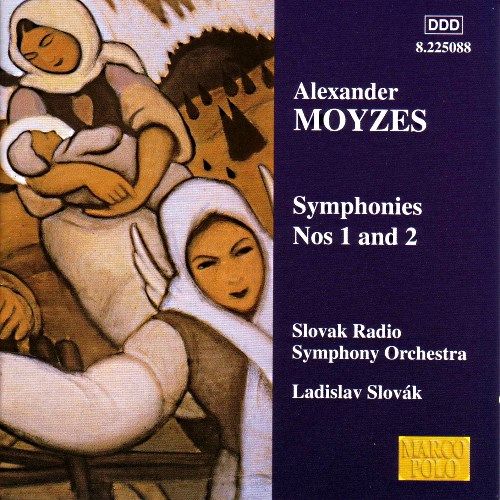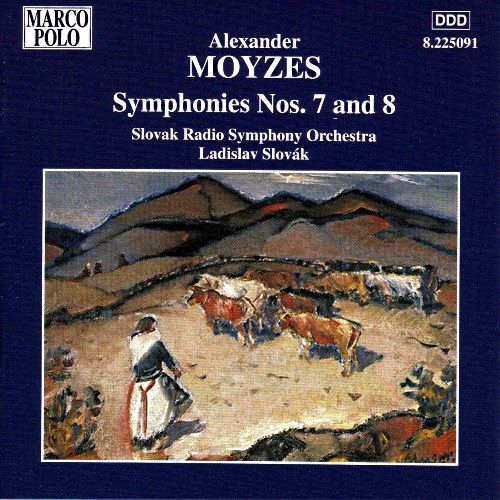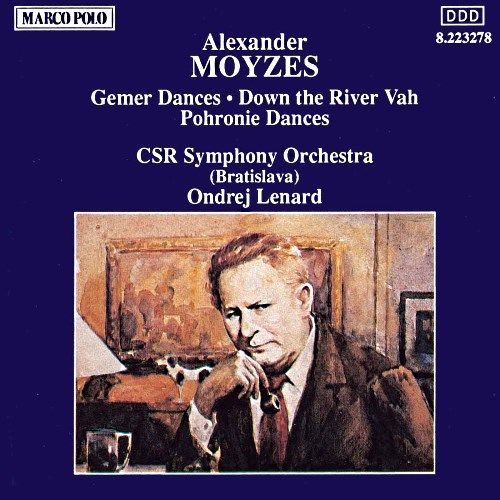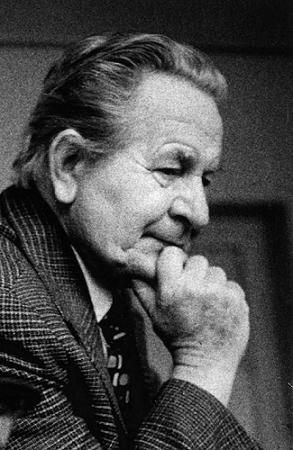wimpel69
02-14-2014, 02:59 PM
Sharing of this collection has ended a long time ago. So no more requests for this, and no
re-ups of my material. Thank you!
Alexander Moyzes, one of the most significant figures in modern Slovak music, was born into a musical
family in 1906 in Northern Slovakia.After earlier technical studies, in 1925 he entered the Prague Conservatory,
where he studied organ, conducting and composition. He graduated in 1929 and went on to study in the master
class of V�tezslav Nov�k, from which he graduated in the following year with his Overture for Orchestra, Opus 10.
It was Nov�k who directed his attention to Slovak music, the source of his inspiration.
In 1929 Moyzes was appointed to the teaching staff of the Music Academy in Bratislava, the Slovak capital. He
became professor of composition at the Bratislava Conservatory in 1941 and spent a number of years as principal
music advisor to Radio Bratislava, until compelled to resign in 1948. On its foundation he was appointed professor of
composition at the Bratislava Music Academy, where he taught no less than three generations of Slovak composers.
He headed the Academy as Rector from 1965 until 1971, and over the years undertook many important functions
in the musical life of his country.
With Eugen Suchon and Jan Cikker, Alexander Moyzes must be considered one of the three leading composers of
his generation in Slovakia. He succeeded in creating a style of composition that was thoroughly Slovak in inspiration,
yet nevertheless took account of contemporary trends in European music, a synthesis that he was to consolidate
in his later years.







Music Composed by
Alexander Moyzes
Played by the
Slovak Radio Symphony Orchestra
Conducted by
Ladislav Slov�k
Ondrej Lenard
"Alexander Moyzes (1906-84), one of the leading Slovakian composers of his generation, succeeded in
creating a style of composition that was primarily Slovak in inspiration yet informed by contemporary
developments in European music. He composed a small body of works, most of which are symphonies
(12). Symphony No. 1 (1928) is a harmonically free work that bears the influence of Scriabin, though
the slow movement indicates a more than casual acquaintance with Debussy's Sir�nes. It takes a little
time to recognize Moyzes' opening thematic snippets as actual melodies, but once this happens the
music takes on a very satisfying shape. Right from its arresting beginning, the two-movement
Symphony No. 2 (1932) is even harder to pin down thematically and tonally. The music is in that
somewhat indeterminate melodic style characteristic of composers such as Eduard Tubin. It's all
very compelling beneath the surface, and the listener's patience is handsomely rewarded in the
finale (which features a second subject straight out of Prokofiev). Moyzes' music is engaging, well
crafted, and beautifully orchestrated--qualities clearly understood and successfully conveyed by
Ladislav Slov�k and his Slovak Radio Symphony Orchestra."
Classics Today
"Three of the four movements of the Fifth Symphony can, broadly speaking, be placed with
Smetana's Festive Symphony, with the folksy elements of Mahler's Symphonies 1 and 4 and with
the celebrations of the last movement of Mahler 7. Moyzes is not niggardly in his use of the drums,
cymbals and triangle. The second movement has a nostalgia and dream-softened melancholia that
does not tear like Shostakovich but is equally telling. Moyzes proves himself a very affecting and
inventive voice, taking as his mulch the autumnal reveries of Brahms 3. There are some glorious
moments here including the relaxation of the high strings counter-pointing each other. Moyzes
found a mood here and sustained it nothing short of brilliantly. The notes are none too specific
but there are indications that this work owes something to the Little Mountain Symphony by
Alexander's father Mikulas (1872-1944); indeed the symphony was dedicated to the fifth
anniversary of Mikulas's death.
The Sixth Symphony is in five movements. It has, in its second, fourth and final movements,
the flickering delightful vigour of Roussel's Second, Kodaly's much later symphony, the scherzo
of Moeran's G minor symphony and some of the abrasion of Kurt Weill in his two symphonies.
There are definite folk inflections, all incisively propelled by the late Ladislav Slovak and his
orchestra who presumably know these symphonies better than anyone. Like the other symphony
it is most lovingly recorded."
Musicweb
"Here are two more symphonies by Alexander Moyzes (1906-84) from Marco Polo, again under
the direction of Ladislav Slovak. Symphony No. 9, written in the early 1970s, is a dark, gloomily
introspective piece, uncannily suggestive of late Shostakovich. ...[the recording] effectively contains
the music's wide dynamic range. The Ninth symphony's agitated second section, rising through a
massive crescendo to a brutal march-like idea, brings suitably baleful sonorities from the brass.
The finale, sardonic and unsettled in mood, is punctuated by some nicely played solo violin passages...
and Slovak solidly and consistently sustains the urgent mood.
In complete contrast, Moyzes' Symphony No. 10 (1977-78) is a broadly confident four-movement
work. The style is straightforward, lyrical, and uncomplicated, the emotional weight being centered
on the slow third movement (Larghetto). An interesting feature is the opening horn solo, strongly
reminiscent of the famous one from Tchaikovsky's Fifth symphony. The soloist here has a woolly
tone and sonorous vibrato. Listen on, though, and you'll discover that this deeply felt movement
also brings the finest music--and certainly the best playing--on the disc. The finale, opening with
a relaxed slow introduction (recalling parts of Brahms' Second symphony), develops into a jubilant Allegro."
Classics Today


Sharing of this collection has ended a long time ago. So no more requests for this, and no
re-ups of my material. Thank you!
Enjoy! Don't share! Buy the originals! :)
re-ups of my material. Thank you!
Alexander Moyzes, one of the most significant figures in modern Slovak music, was born into a musical
family in 1906 in Northern Slovakia.After earlier technical studies, in 1925 he entered the Prague Conservatory,
where he studied organ, conducting and composition. He graduated in 1929 and went on to study in the master
class of V�tezslav Nov�k, from which he graduated in the following year with his Overture for Orchestra, Opus 10.
It was Nov�k who directed his attention to Slovak music, the source of his inspiration.
In 1929 Moyzes was appointed to the teaching staff of the Music Academy in Bratislava, the Slovak capital. He
became professor of composition at the Bratislava Conservatory in 1941 and spent a number of years as principal
music advisor to Radio Bratislava, until compelled to resign in 1948. On its foundation he was appointed professor of
composition at the Bratislava Music Academy, where he taught no less than three generations of Slovak composers.
He headed the Academy as Rector from 1965 until 1971, and over the years undertook many important functions
in the musical life of his country.
With Eugen Suchon and Jan Cikker, Alexander Moyzes must be considered one of the three leading composers of
his generation in Slovakia. He succeeded in creating a style of composition that was thoroughly Slovak in inspiration,
yet nevertheless took account of contemporary trends in European music, a synthesis that he was to consolidate
in his later years.







Music Composed by
Alexander Moyzes
Played by the
Slovak Radio Symphony Orchestra
Conducted by
Ladislav Slov�k
Ondrej Lenard
"Alexander Moyzes (1906-84), one of the leading Slovakian composers of his generation, succeeded in
creating a style of composition that was primarily Slovak in inspiration yet informed by contemporary
developments in European music. He composed a small body of works, most of which are symphonies
(12). Symphony No. 1 (1928) is a harmonically free work that bears the influence of Scriabin, though
the slow movement indicates a more than casual acquaintance with Debussy's Sir�nes. It takes a little
time to recognize Moyzes' opening thematic snippets as actual melodies, but once this happens the
music takes on a very satisfying shape. Right from its arresting beginning, the two-movement
Symphony No. 2 (1932) is even harder to pin down thematically and tonally. The music is in that
somewhat indeterminate melodic style characteristic of composers such as Eduard Tubin. It's all
very compelling beneath the surface, and the listener's patience is handsomely rewarded in the
finale (which features a second subject straight out of Prokofiev). Moyzes' music is engaging, well
crafted, and beautifully orchestrated--qualities clearly understood and successfully conveyed by
Ladislav Slov�k and his Slovak Radio Symphony Orchestra."
Classics Today
"Three of the four movements of the Fifth Symphony can, broadly speaking, be placed with
Smetana's Festive Symphony, with the folksy elements of Mahler's Symphonies 1 and 4 and with
the celebrations of the last movement of Mahler 7. Moyzes is not niggardly in his use of the drums,
cymbals and triangle. The second movement has a nostalgia and dream-softened melancholia that
does not tear like Shostakovich but is equally telling. Moyzes proves himself a very affecting and
inventive voice, taking as his mulch the autumnal reveries of Brahms 3. There are some glorious
moments here including the relaxation of the high strings counter-pointing each other. Moyzes
found a mood here and sustained it nothing short of brilliantly. The notes are none too specific
but there are indications that this work owes something to the Little Mountain Symphony by
Alexander's father Mikulas (1872-1944); indeed the symphony was dedicated to the fifth
anniversary of Mikulas's death.
The Sixth Symphony is in five movements. It has, in its second, fourth and final movements,
the flickering delightful vigour of Roussel's Second, Kodaly's much later symphony, the scherzo
of Moeran's G minor symphony and some of the abrasion of Kurt Weill in his two symphonies.
There are definite folk inflections, all incisively propelled by the late Ladislav Slovak and his
orchestra who presumably know these symphonies better than anyone. Like the other symphony
it is most lovingly recorded."
Musicweb
"Here are two more symphonies by Alexander Moyzes (1906-84) from Marco Polo, again under
the direction of Ladislav Slovak. Symphony No. 9, written in the early 1970s, is a dark, gloomily
introspective piece, uncannily suggestive of late Shostakovich. ...[the recording] effectively contains
the music's wide dynamic range. The Ninth symphony's agitated second section, rising through a
massive crescendo to a brutal march-like idea, brings suitably baleful sonorities from the brass.
The finale, sardonic and unsettled in mood, is punctuated by some nicely played solo violin passages...
and Slovak solidly and consistently sustains the urgent mood.
In complete contrast, Moyzes' Symphony No. 10 (1977-78) is a broadly confident four-movement
work. The style is straightforward, lyrical, and uncomplicated, the emotional weight being centered
on the slow third movement (Larghetto). An interesting feature is the opening horn solo, strongly
reminiscent of the famous one from Tchaikovsky's Fifth symphony. The soloist here has a woolly
tone and sonorous vibrato. Listen on, though, and you'll discover that this deeply felt movement
also brings the finest music--and certainly the best playing--on the disc. The finale, opening with
a relaxed slow introduction (recalling parts of Brahms' Second symphony), develops into a jubilant Allegro."
Classics Today


Sharing of this collection has ended a long time ago. So no more requests for this, and no
re-ups of my material. Thank you!
Enjoy! Don't share! Buy the originals! :)
